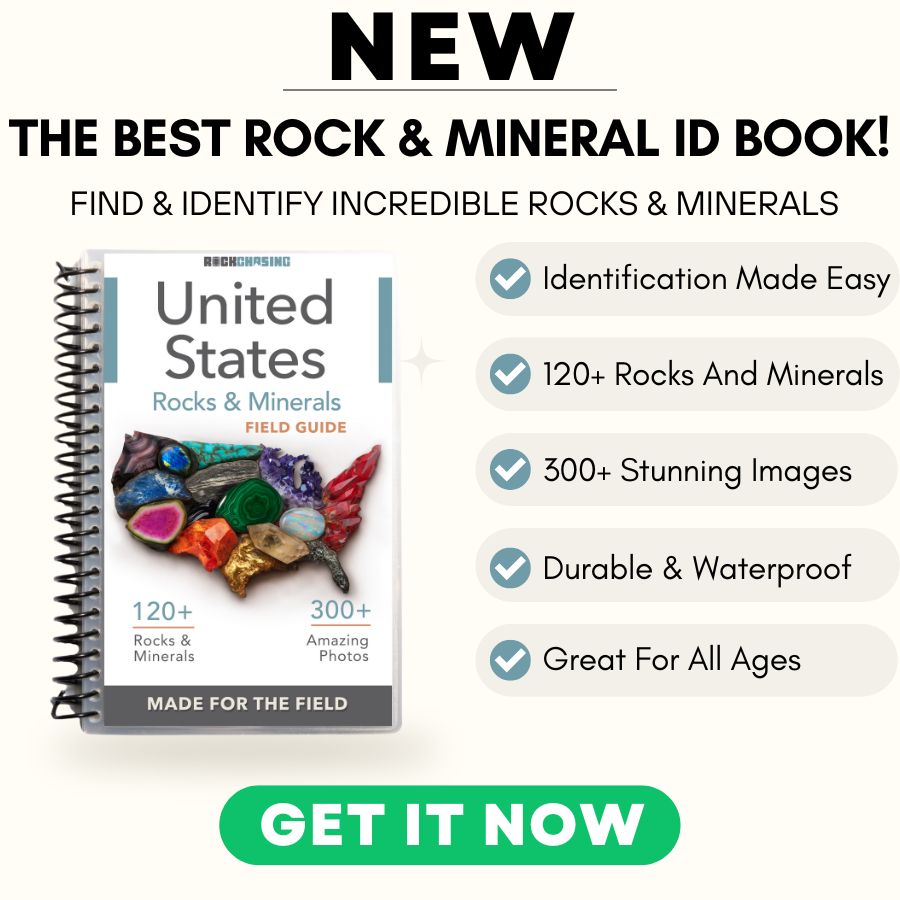With so many rocks, minerals, and gems to choose from, Maryland could be a treasure hunter’s dream. Imagine going through the beautiful scenery of the Old Line State. There could be hidden gems under your feet that have been there for a long time!
You’re in luck if you want to know what rocks, gems, and minerals you can find in the state. This article will be your helpful tour guide that leads you to your treasure chest and tells you everything you need to know.
So, the next time you pick up a cool rock, you’ll know if it’s a gem or just a pebble. Let’s get started and make rock hunting your next big journey!
A List of The Common Rocks, Stones, and Minerals Found in Maryland
First, let’s talk about some of the state’s most well-known rocks and minerals. Click on the links below to read the full guides, which we go into a lot of detail:
The Maryland State Rock, Mineral, and Gem
For your reference, here are the official state gems of Maryland that you should know:
| Maryland State Rock | None |
| Maryland State Mineral | None |
| Maryland State Gem | Patuxent River Stone |
Visit the site of the Maryland Department of Natural Resources (DNR) to learn more about the state’s geology policy.
Always Confirm Access and Collection Rules!
Before heading out to any of the locations on our list you need to confirm access requirements and collection rules for both public and private locations directly with the location. We haven’t personally verified every location and the access requirements and collection rules often change without notice.
Many of the locations we mention will not allow collecting but are still great places for those who love to find beautiful rocks and minerals in the wild without keeping them. We also can’t guarantee you will find anything in these locations since they are constantly changing.
Always get updated information directly from the source ahead of time to ensure responsible rockhounding. If you want even more current options it’s always a good idea to contact local rock and mineral clubs and groups
Chrysocolla
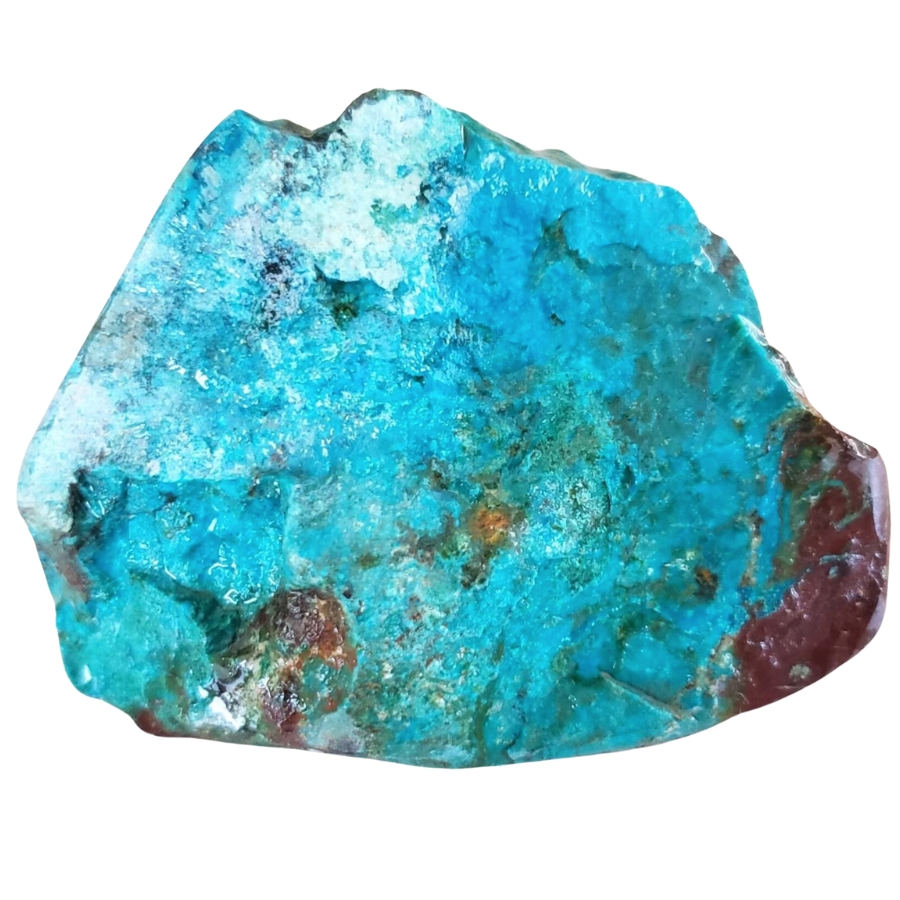
Chrysocolla is a stunning crystal that looks like a frozen ocean wave. The color is usually very bright and vivid blue or blue-green, with a shiny shine that makes it stand out.
It looks like the best parts of the sky and the sea mixed. This mineral is more than just pretty; it’s also like a history book about the Earth’s development. It’s beautiful, and you can’t find anything like this anywhere else.
Chrysocolla forms where copper is present in the ground, usually in places where there has been some volcanic activity in the past. Copper changes into this beautiful material over time with the help of water, silica, and certain geological conditions.
Chrysocolla is valuable because it’s pretty and isn’t found very often. It has also been used in art and jewelry for hundreds of years, which makes it very important to history and jewelry lovers. It’s more than just a rock; it’s art made by Earth.
Where you can find Chrysocolla in Maryland
There are many places in the state where you can find chrysocolla. Here are some of them:
- Repp Mine
- Liberty Mine
Epidote
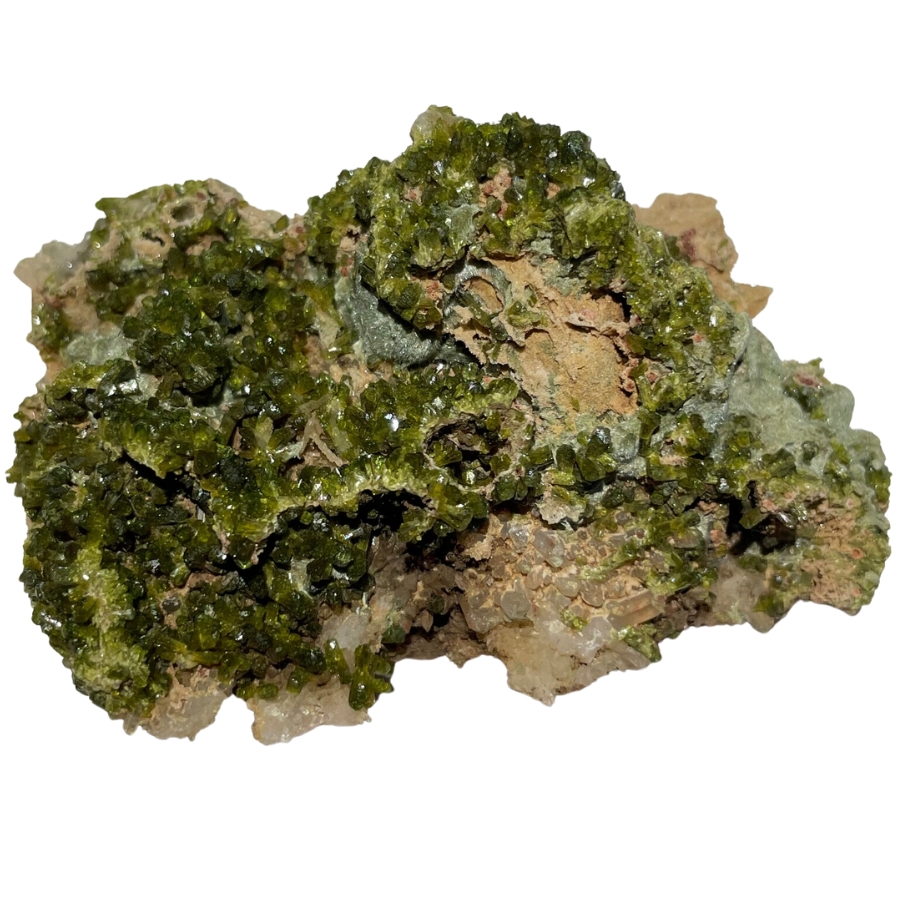
Sometimes called the “chameleon of minerals,” epidote can change looks as needed. This cool mineral can look different based on what other minerals are around when it forms.
Although it’s usually a nice lime green color, it can be almost black or even yellowish if it wants to be. Nature has given it a mood ring-like quality. Magmatic forces (metamorphism) change rocks in a way that makes epidote.
Like the rocks went into a big Earth oven and came out changed, with epidote being one of the new minerals.
Because Maryland’s rocks have been around long, you might find different kinds of epidote when digging. People who know where to look can find this mineral, but it’s not the most well-known in the state.
When scientists study this mineral, they can learn a lot about how temperatures and pressures change over time deep inside the Earth. Plus, people who make jewelry like it because of its unique color and the way it shines.
This makes it even more special for people who like to wear unique things. People stop and look again when they see epidote, whether for health or fashion.
Where you can find Epidote in Maryland
There is a lot of epidote in the state, like in these places:
Feldspar
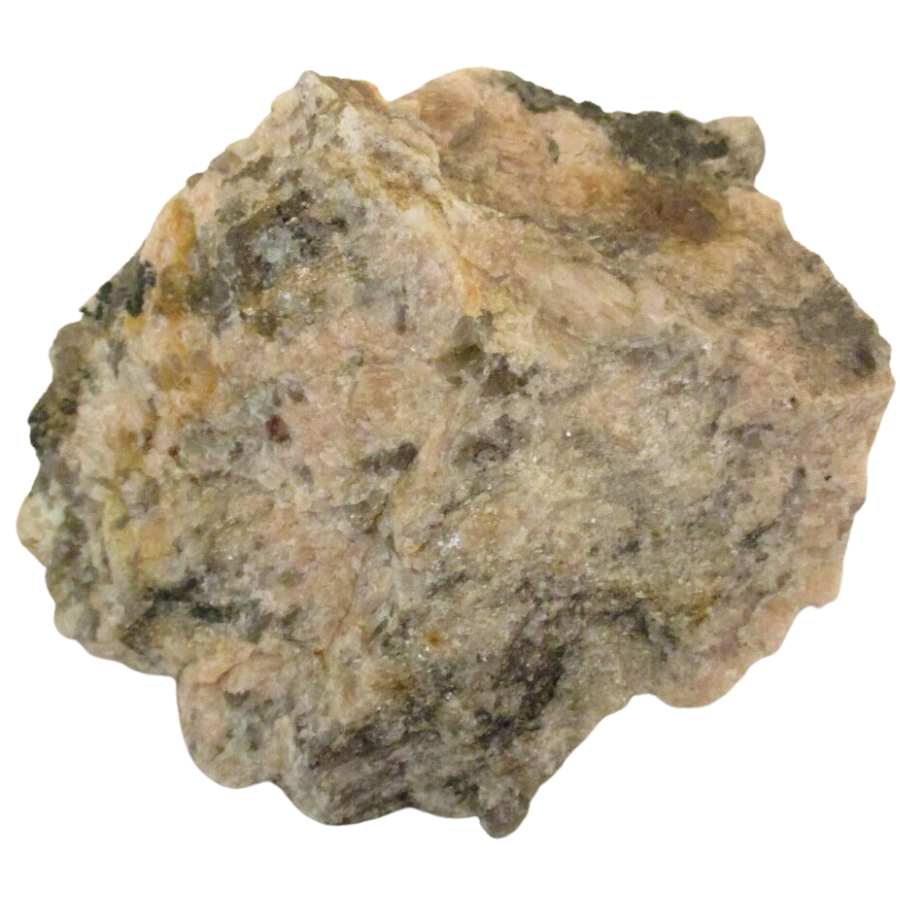
Feldspar is a mineral that gets little credit for its importance. Being common doesn’t mean it’s boring, though. This cool, shiny substance comes in many colors, like pink, white, gray, and tan.
It shines in the sun. Rocks like granite, which forms mountains and much of the Earth’s crust, have it.
Feldspar is a mineral that forms crystals when magma, the hot, liquid rock inside volcanoes, cools down. Also, other rocks change over time through metamorphism, which uses heat and pressure.
Geology-wise, Maryland has a lot of different rocks, so feldspar is welcome here. Explore the state’s mountains or even look for it in the sand on the side of the road!
Feldspar is valuable because it’s used to make things like window glass and dishware. Our homes would not be the same without it! Plus, some kinds of feldspar are very pretty and are used to make jewelry.
We use it daily, even if we don’t always realize it. It can be found in a ring on someone’s finger or the glass in your windows.
Where you can find Feldspar in Maryland
These places in Maryland have a lot of feldspar:
- Bare Hills
- Soldier’s Delight Natural Environment Area
Gneiss
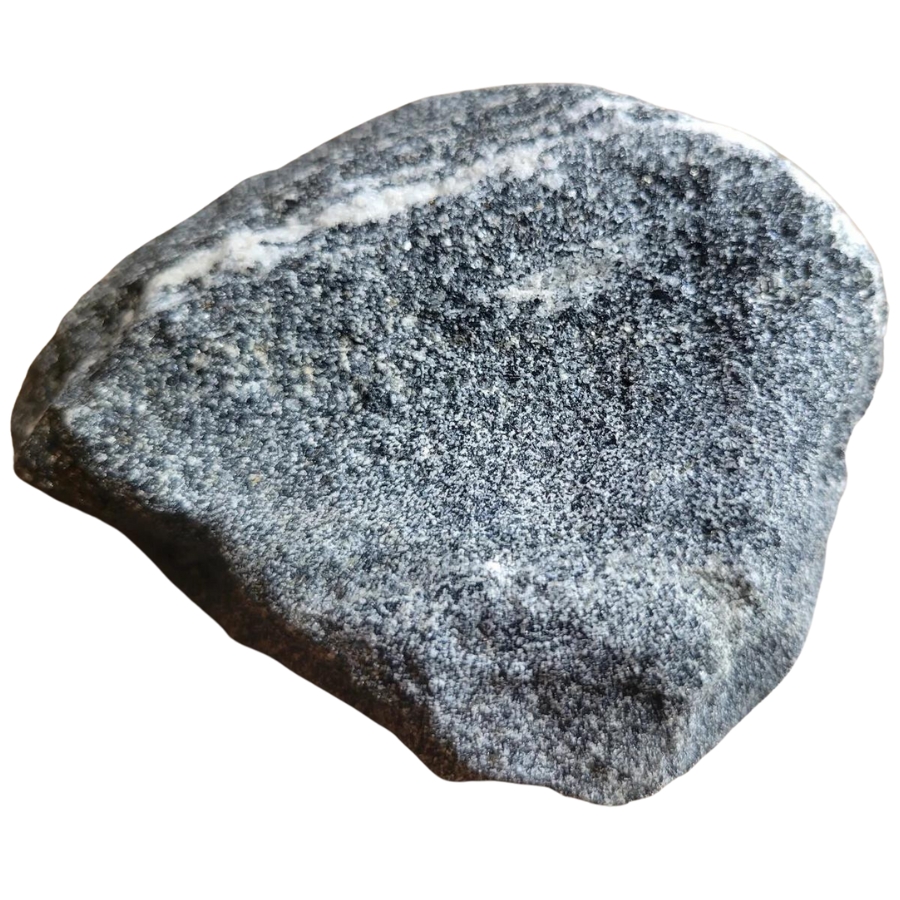
Gneiss is a rock with cool stripes that resemble a zebra on the earth’s crust. The stripes are caused by very high temperatures and a lot of pressure deep in the ground, which pushes the minerals in the rock into layers.
Each piece of gneiss is unique because of the bands of different colors these layers make. You didn’t make it in art class, but it looks like a real work of art!
Gneiss is an important part of Maryland’s history, so the state is proud. It has been around for a very long time and keeps getting cooler over time.
The Appalachian Mountains in Maryland are home to gneiss. You can find different kinds of gneiss here.
Gneiss is valuable not only because it looks nice but also because it’s solid. Historic houses and monuments use it to last for a long time. It’s more than just a rock; it’s a reminder of how powerful our world is and how incredible things it can make.
Where you can find Gneiss in Maryland
This is where you can find a lot of Gneiss in Maryland:
- Bare Hills
- Funks Pond Recreational Area
Magnesite
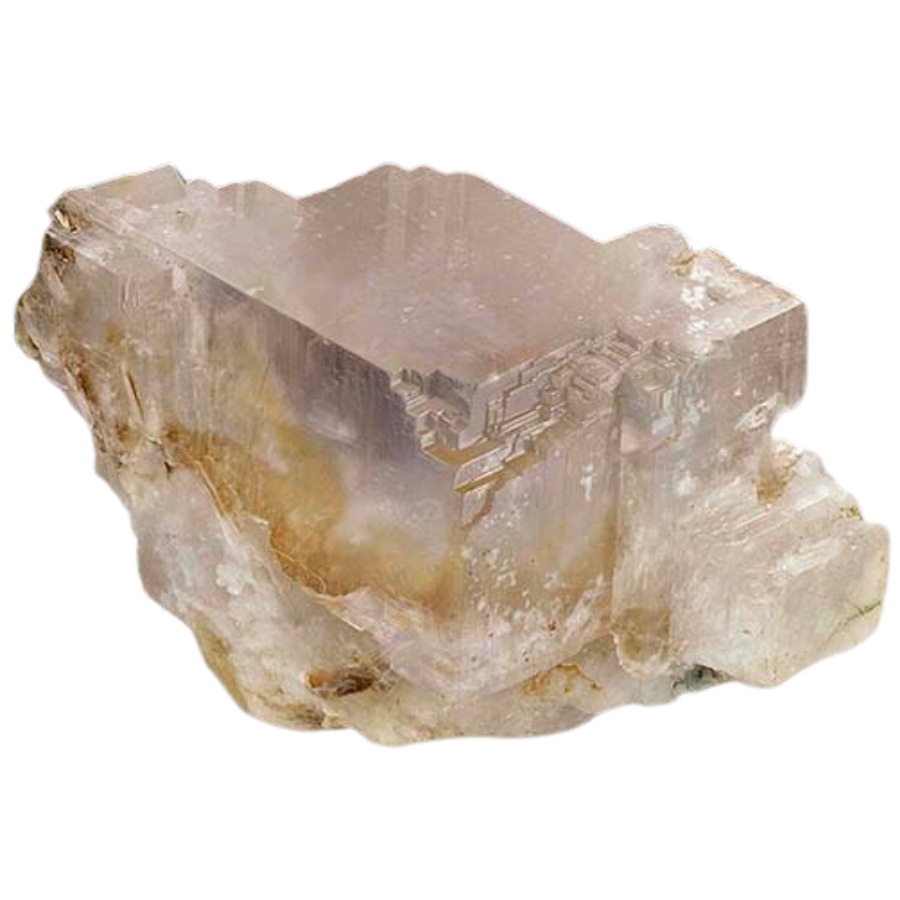
You can’t tell what color magnesite is because it’s usually just white or a pale yellow. Magnesite is cool because it soaks up a specific element called magnesium, like a sponge.
It looks like chalk and can be shiny or even have a pearly sheen, which makes it interesting to look at. There are several ways that a magnesite can be formed.
It can happen when seawater disappears, leaving behind minerals, or when rocks high in magnesium are heated and pushed around inside the Earth.
Magnesite isn’t the main attraction in Maryland because it doesn’t show up very often. Because the state has a lot of different types of rocks, magnesite could be found in places where salty seas used to be or where the Earth has been heating minerals under pressure.
It’s turned into magnesium oxide, used to make things like cement, fireproofing products, and even medicine. It’s also sometimes used to make items sparkle even more.
Magnesite is a pretty expensive mineral that doesn’t get as much attention as diamonds.
Where you can find Magnesite in Maryland
This is where you can find a lot of Gneiss in Maryland:
- Funks Pond Recreational Area
- Rock Springs
- Soldier’s Delight Natural Environment Area
Malachite
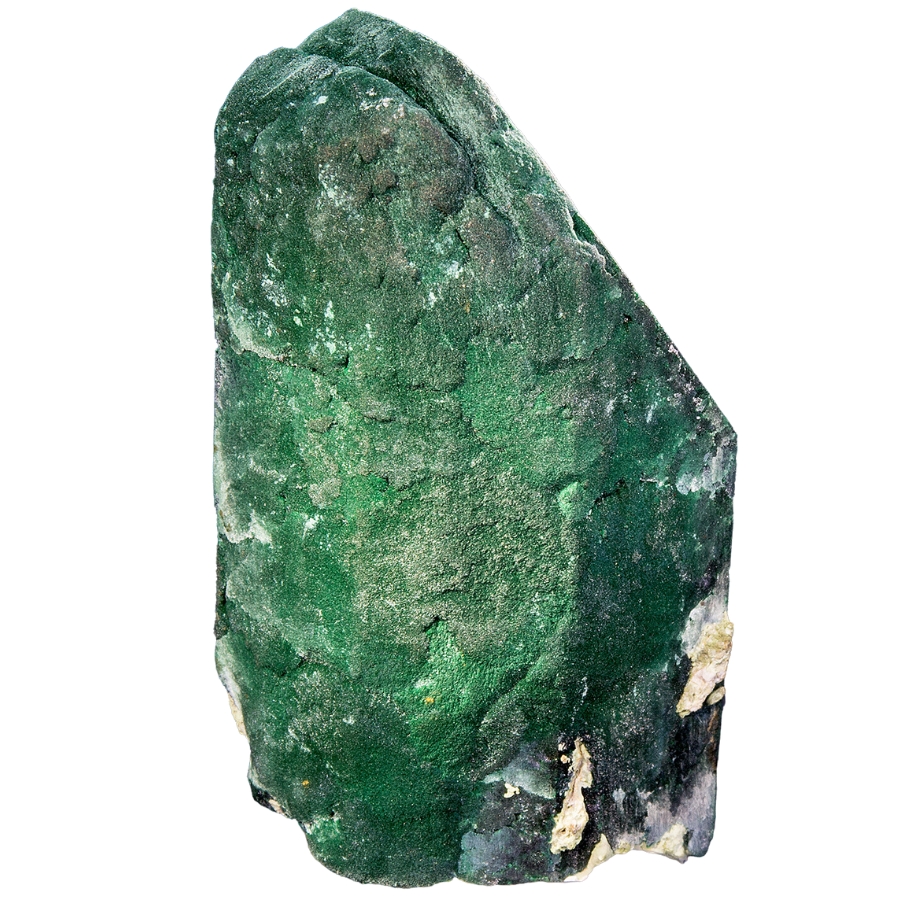
You can really see how beautiful malachite is because of its deep, rich green color and lovely swirling designs. Each stone has layers that look like tiny forests and tell stories about the mineral’s history.
The bright green color of this material comes from the copper that makes it up. It starts to form when oxygen comes in contact with copper ores, like copper’s buried homes. Just add some water and you have malachite!
Copper was once the most valuable metal in the state, and you might be able to find malachite hiding in old mines and nature areas. Because copper is or was its family, it loves being where copper is or was.
There are both small and large pieces of the mineral in the state. The larger pieces will show off the amazing patterns on the stone.
Beyond its beauty, malachite has been valued for thousands of years because it has many valuable properties. Some time ago, it was ground up to make paint colors. Nowadays, it’s still used to create beautiful jewelry and decorations.
Where you can find Malachite in Maryland
In Maryland, you can find a lot of malachite here:
- Dollyhyde Creek
- Liberty Mine
- New Windsor
- Repp Mine
- Springfield Mine
Serpentine
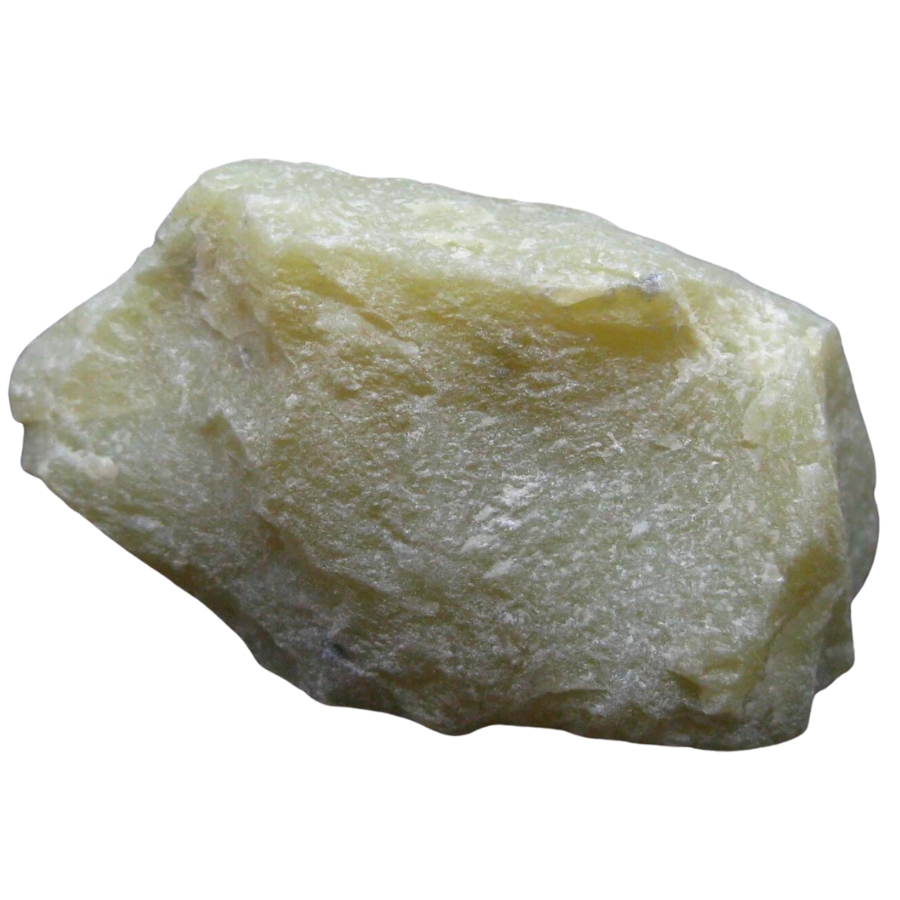
Serpentine isn’t just one mineral; it’s a group of minerals that work together to make a rock with a surprise: because it’s cool green and waxy, it’s often confused for jade. Serpentine shapes are very peculiar.
Its life cycle begins deep below the ocean floor, where rocks high in magnesium and low in silica are pushed up by the Earth’s moves. When these rocks come into contact with water, they change into serpentine, like redesigning rocks.
In Maryland, serpentine rocks are a big deal. There’s even a state park named after it—Soldiers Delight Natural Environmental Area. This spot is famous for its serpentine barrens, where the soil contains serpentine minerals.
These areas aren’t great for plants, but they’re perfect for rockhounds looking for a piece of this green treasure. The serpentine found here is usually the waxy, green kind that can make you think you’ve found a jade jackpot!
It has a certain charm that makes it great for carving and making cool things like jewelry or statues. However, serpentine isn’t just pretty; it can also be used in science in very useful ways.
It gives scientists a lot of information about how the crust of the Earth has changed over time. Additionally, it has been utilized in production of building supplies.
Where you can find Serpentine in Maryland
Maryland has a lot of Serpentine in these places:
- Chrome Hill
- Funks Pond Recreational Area
- Reed Mine
- Soldiers Delight Natural Environmental Area
- Wilkins Chrome Mine
Tremolite
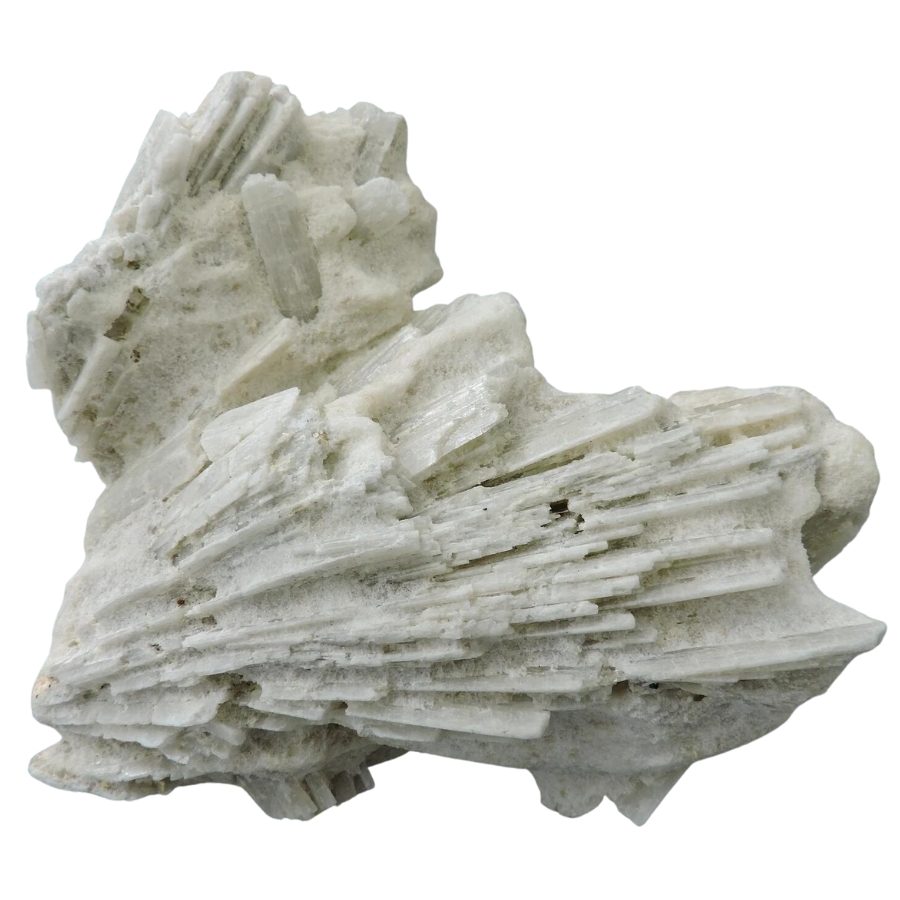
Tremolite is related to asbestos, but don’t be scared—if you leave it alone in nature, it’s not the dangerous kind. Most of the time, this material is white, but it can also be dark green or even clear.
In a cool process, tremolite is made when dolomite and quartz change shape under high pressure and temperature.
Think of it like making a cake: these minerals mix below the surface of the Earth and “bake” for millions of years. After that, tremolite forms.
Geologists can look at tremolite to learn more about the environment where it formed, which is deep inside the Earth. Collectors will also like it because of its silky shine and crystal forms.
Because it has such a unique look, it was once even used in jewelry and as a decoration stone. Some people might not think of tremolite as the most essential material, but it’s crucial in both art and science.
Where you can find Tremolite in Maryland
In Maryland, you can find a lot of tremolite here:
- Bare Hills
- Sykesville area
The Gemstones Found In Maryland
Let’s talk more about Maryland’s gems. We’ve also put together a list of our most in-depth articles in case you want a full guide:
Amber

Amber isn’t just any rock; it’s stored tree sap! Think about it: sticky sap from old trees is buried, and after millions of years, it turns into this beautiful gold rock.
Trees and plants use them as time capsules, and sometimes, they even catch bugs and leaves from the past inside them. A light lemon-colored amber is one shade. A deep, rich orange-brown that looks like honey is another.
You can find amber in Maryland in a few different places, mostly in spots where there used to be a lot of trees a very long time ago. Maryland’s amber isn’t just amber; it can teach you about history.
At times, this amber is special because it hides little old treasures inside it. It’s not something you’ll often find when rock hunting, but when you do, it’s like finding a piece of Maryland’s natural history from a long time ago.
Amber has been loved for a very long time, and not just because it looks nice. People have made jewelry out of it that glows like little sun drops. Scientists also find it very interesting.
They look at it to learn about how things were in the past. For all of us, amber reminds us of how amazing and strange nature can be. Made from tree sap, amber is a gem that will last millions of years.
Where you can find Amber in Maryland
You can try to find them in these places in the state:
- North Perry Point
- Point Lookout area
- Sullivans Cove
Amethyst
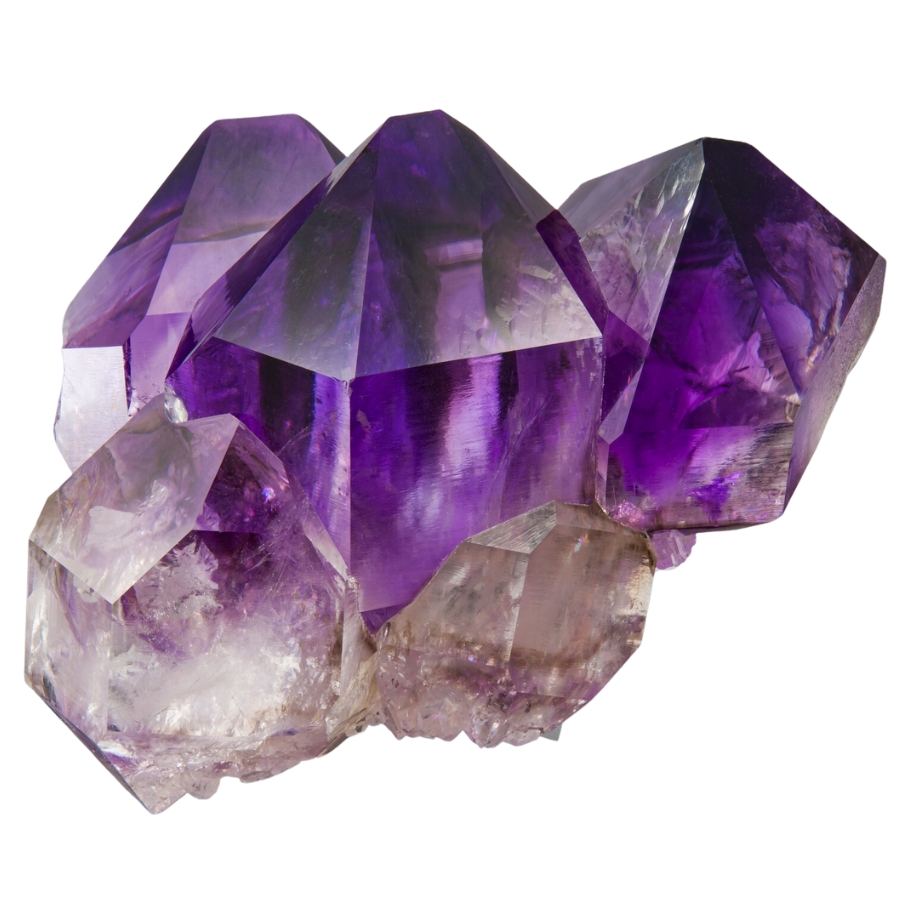
Amethyst is one of those gems that stands out because of its beautiful purple color. This is a type of quartz, which is a pretty standard material. Its purple color is caused by radiation hitting the iron inside the quartz deep inside the Earth.
For thousands of years, crystals grow quietly in geodes, small rocks in the ground, until they’re ready to show off their beauty. This is how amethyst gets its name.
Maryland’s amethysts are like little bits of local magic. They’re not as big or dark as the well-known stones from Brazil or Uruguay, but they’re still pretty cool.
Based on where you find them and how much iron they have inside, their soft purple color can range from a light pink to a more royal purple.
A lot of people have been crazy about amethyst for a long time. This is where an amethyst’s value is. It was considered to be as valuable as diamonds. People still love it because it’s beautiful and can make any piece of jewelry look like it was made for a king or queen.
This makes it a popular choice for people who like their gems to make them feel good. So, amethyst gives everything it touches a bit of a royal sparkle, whether it’s a crown or a necklace.
Where you can find Amethyst in Maryland
Maryland is full of amethyst rocks, but these are the best spots to find them:
- White Marsh
Aquamarine
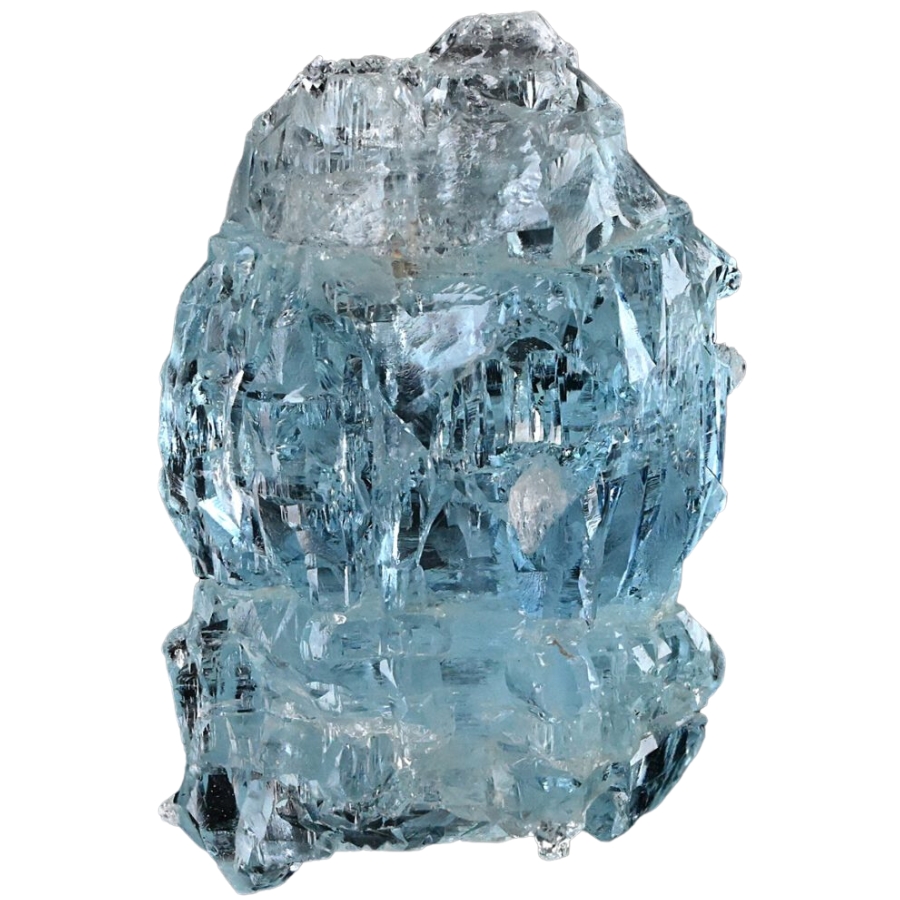
You can hold a piece of the sky in your hand when you look at aquamarine. There are different shades of blue in this gem, from light blue to deep sea green.
This gem is a type of beryl, which is the same family of minerals that emeralds are. But aquamarine is cool blue instead of green because it has iron in it. It forms deep underground in rocks known as pegmatites.
These rocks are like treasure boxes for the Earth—they’re full of big crystals and other surprises.
Aquamarine isn’t very common in Maryland, which makes it even more exciting when you do find it. These pegmatites can be hidden in the middle of the state, which is where the rock is most often found.
Maryland’s aquamarines are pretty, but not as big and fancy as the ones you might find in a jewelry shop. They are a soft, watery blue color that can make you think of a sunny day in Maryland with a clear sky.
In the past, sailors carried it as a good stone to keep them safe at sea. Even now, it still stands for safety and a happy marriage. Aquamarine is valuable and more than just a pretty stone to look at; it has a lot of history and meaning behind it.
Where you can find Aquamarine in Maryland
You can find aquamarine all over Maryland, but most of them are found in these places:
- Baltimore County
Diopside
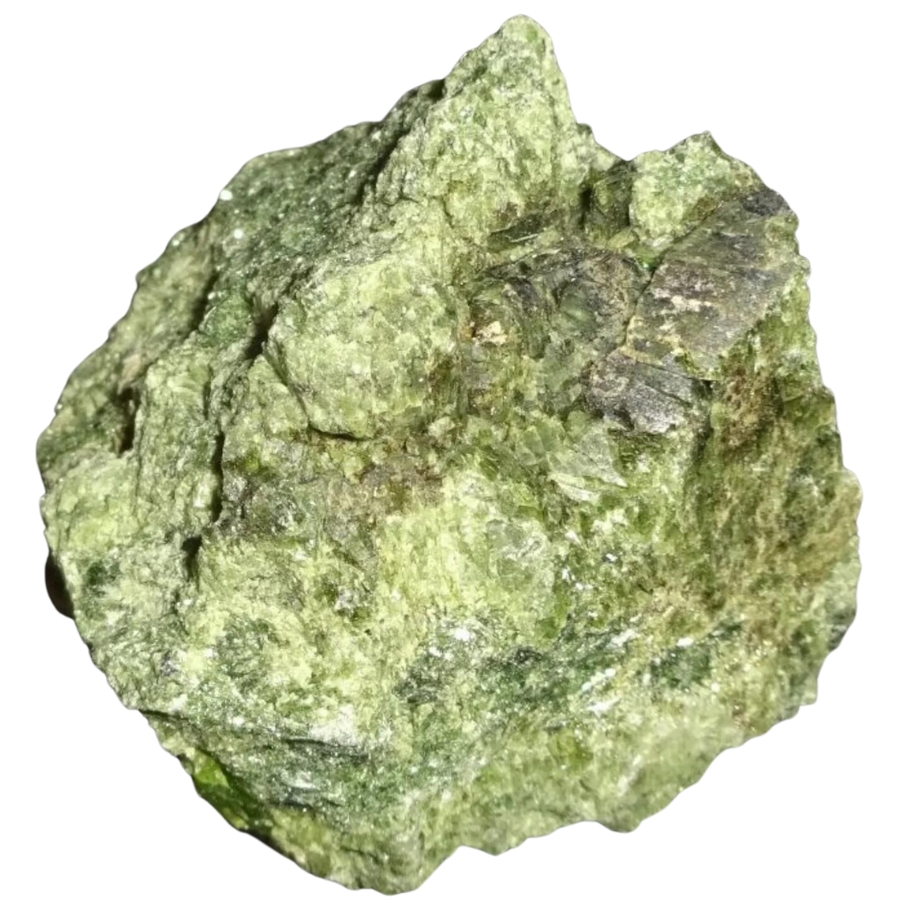
Diopside is an interesting mineral that can really stand out because of its bright green color. However, it can also be found in white or light green shades. The less well-known cousin of the more well-known emerald, but still pretty cool.
When lava from volcanoes cools down very fast or when certain rocks get squished and heated up deep in the Earth, diopside is formed. The conditions on Earth that make it happen are pretty tough, like a superhero for minerals.
Diopside isn’t exactly sitting around on the sidewalk in Maryland, but it’s a part of the underground scene in the state. Thanks to its long geological past, Maryland has a lot of different types of rocks.
Because of this, you might find this green gem while you’re out exploring, especially in places where there have been old volcanic activity or where the earth has been baking (metamorphosis) for a long time.
People who like jewelry and gems like diopside because of its color and sparkle. Also, diopside is a very important piece of information for experts trying to figure out the history of the Earth’s crust.
Where you can find Diopside in Maryland
Most of the diopside in Maryland can be found in these places:
- Hunting Hill
- Rockville Crushed Stone Quarry
Opal
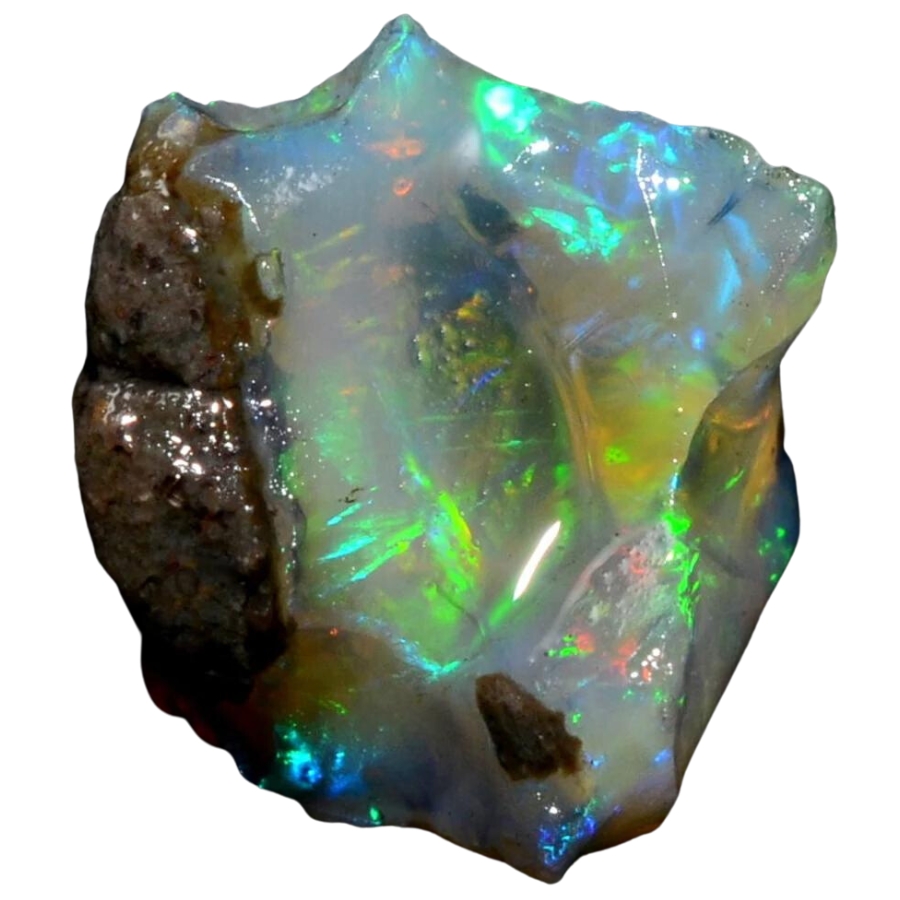
Opal is a stone that looks like it has a rainbow inside it. It’s not just one color; as you move it in the light, it shakes and changes, showing a wide range of colors. Small amounts of water and calcium inside the opal make this magic work.
To make it, water has to flow through the ground, pick up silica from sandstone, and then settle into cracks and holes in rocks. There is no longer any water after a long time because it has evaporated. What’s left? A lovely opal!
To find opal in Maryland is a bit like going on a treasure hunt. Even though it’s not the most common stone in the state, you might find one in the center part of the state.
A lot of the opals in Maryland are the usual type. They have a nice milky color with pretty flashes of color inside. Even though they’re not the flashy kind you see in jewelry shops, they’re still breathtaking.
People value opal for its beauty and its color changes when light hits it. This makes it a popular stone for making bracelets and rings. It’s not just about how you look, though.
Because each opal is different, with its design and colors, having one is like having a one-of-a-kind work of natural art.
Where you can find Opal in Maryland
Opal can be found all over Maryland, but mostly in these places:
- Beltsville area iron mines
- Hunting Hill
- Rockville Crushed Stone Quarry
Zircon
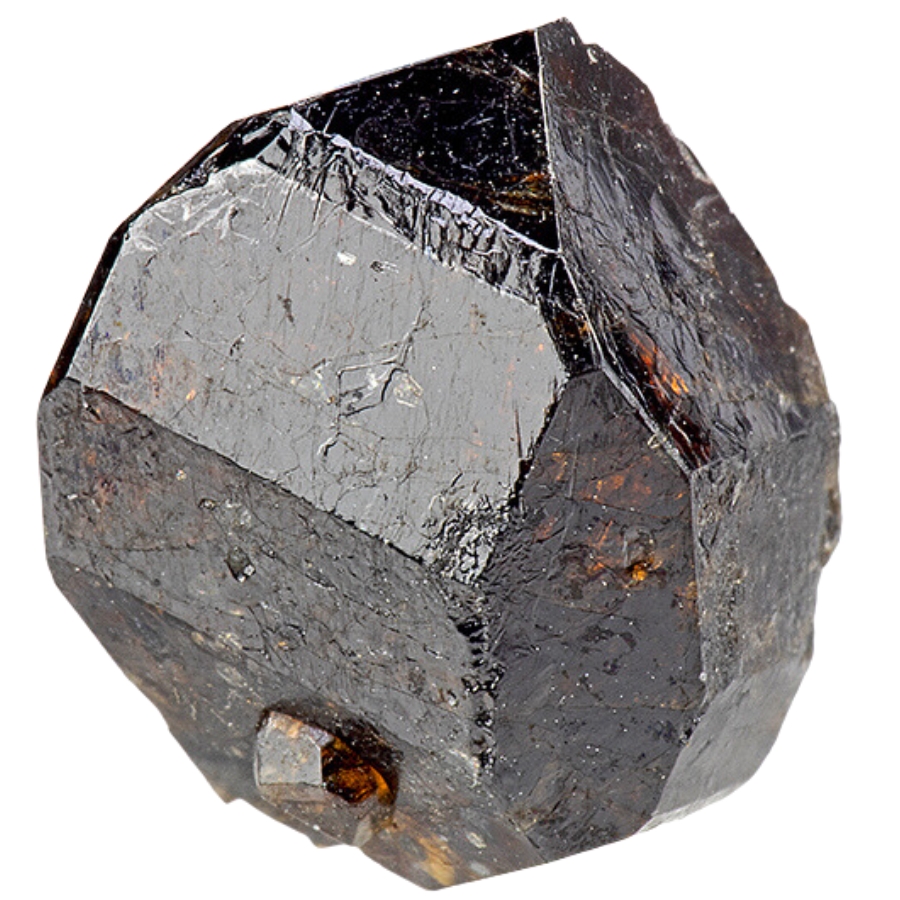
Because it is one of the oldest minerals on Earth, zircon is like the parent of all jewels. But it’s not just old; it’s also really cool. Zircon comes in many colors, including red, green, brown, and its most famous color, blue that sparkles.
It can be made in many ways, such as when molten rock cools down during a volcanic explosion and zircon crystals begin to form. Besides that, it can be found in rocks that have been changed over time by heat and pressure.
Zircon isn’t something you’ll find in Maryland, but it is a part of the rock scene there. They are very small, almost too small to see. Others may be big enough for their shine to catch your eye.
While they might not always look like the zircons in jewelry stores, they’re still a great find.
Zircon is valuable for more than just how it looks. Yes, because it sparkles almost as much as a diamond, it looks great in rings and chains. It’s very important to science, not just for its beauty.
Where you can find Zircon in Maryland
Zircon is easy to find in Maryland, mostly in these places:
- Bear Island
The Crystals Found In Maryland
Folks who like to collect gems and crystals will find many beautiful ones in Maryland. These rocks have been talked about a lot.
Furthermore, read our article about the places in Maryland where you can discover crystals:
Azurite
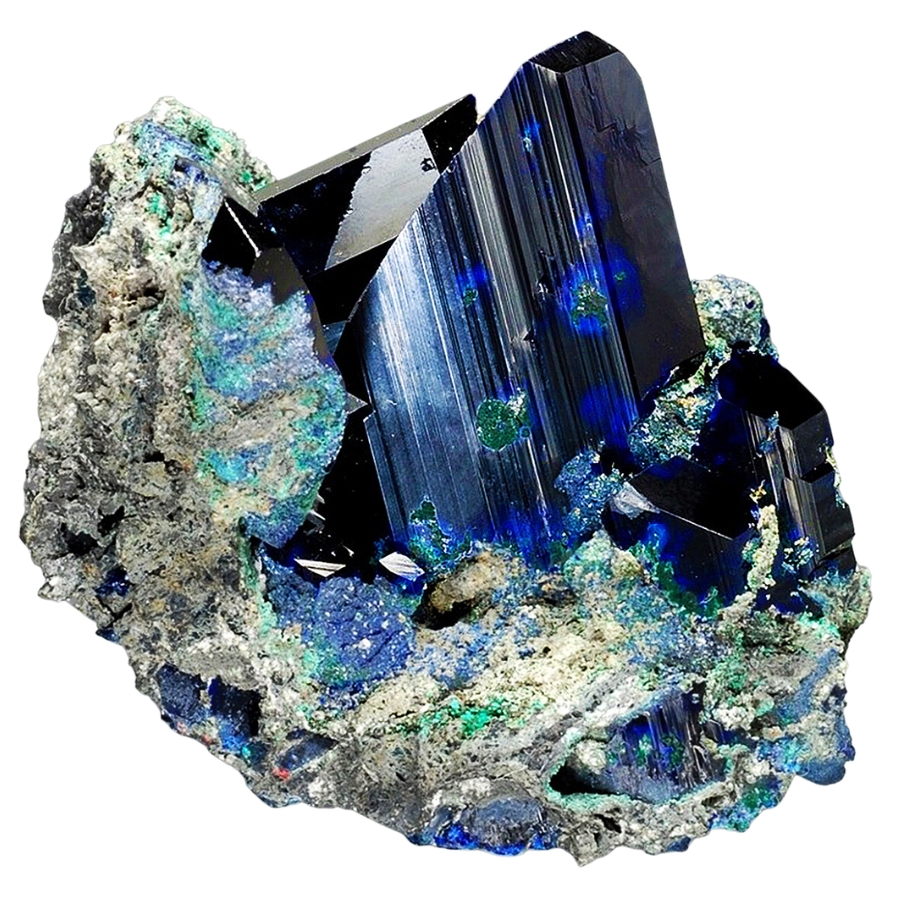
The deep blue color of azurite is so beautiful that it looks like a piece of the sky has dropped to Earth. It’s as blue as a summer day. You can find this mineral where there is copper, usually at the top of copper ore sources.
The chemical reaction between copper, oxygen, carbon, and water—usually from rainwater or groundwater—makes azurite. Anytime azurite is exposed to water and air for too long, it can change into malachite, a crystal that is just as beautiful but green.
Azurite isn’t the most common element in Maryland, but it’s like a secret treat for someone who looks closely. There are many old mines and natural places in the state that were once full of copper.
That’s where you might find this blue beauty. Even though the azurite in Maryland isn’t in big, chunky chunks, the blue color of even the smallest pieces makes it a cool find.
Azurite is valuable not only because of how it looks, but also because of what it has done in art and history. A long time ago, it was ground up to make a blue paint ingredient.
Mineral fans still love it because of its deep color and the way it shines in the light. It’s also a natural place for artists to get ideas. It’s a real work of nature art, whether it’s in a museum or a rock collection.
Where you can find Azurite in Maryland
Azurite is easy to find in Maryland, especially in these spots:
- Liberty Mine
- New Windsor
- Repp Mine
Bornite
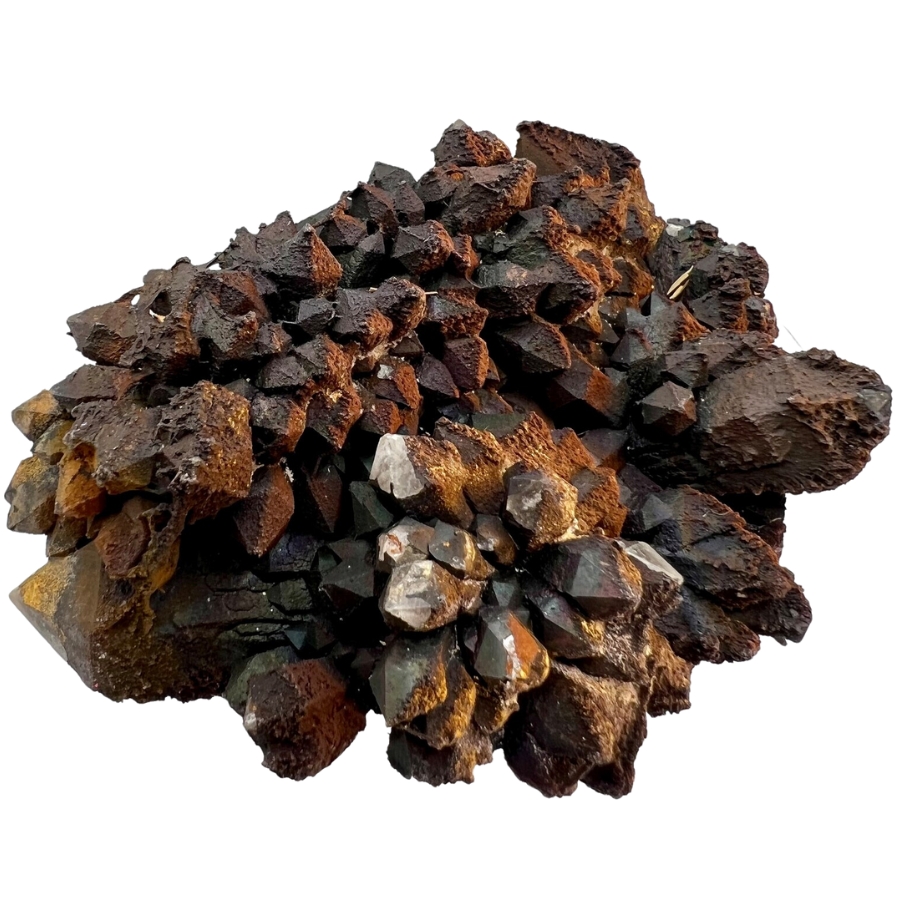
Bornite is a mineral that comes in a lot of different colors. People often call it “peacock ore” because it looks like a peacock’s wings with its different shades of purple, blue, and green.
This cool rock is made up of copper, iron, and sulfur. Deep underground, where copper is found, especially in places where volcanoes erupt a lot, it forms. Bornite is made possible by the heat and chemical processes that happen in volcanoes.
It starts to tarnish in the air, which is when the beautiful colors appear—it’s like nature’s own tie-dye!
You’ll have a better chance of seeing this bright mineral in places where copper extraction used to happen. Even if the bornite in Maryland doesn’t always have the big, bright colors you see in pictures, it’s still pretty cool to look at and touch.
Several things make bornite valuable. Not only is it pretty and colorful, but it also gives us copper, which we use for many things, like coins and lines. This rock also has a unique and colorful tarnish that makes rock fans love it.
Bornite is a gemstone that makes us think about how beautiful and full of color the world is.
Where you can find Bornite in Maryland
Here are some places in Maryland where you can find bornite:
- Dollyhyde Creek
- Hammond Prospect
- New Windsor
Brucite
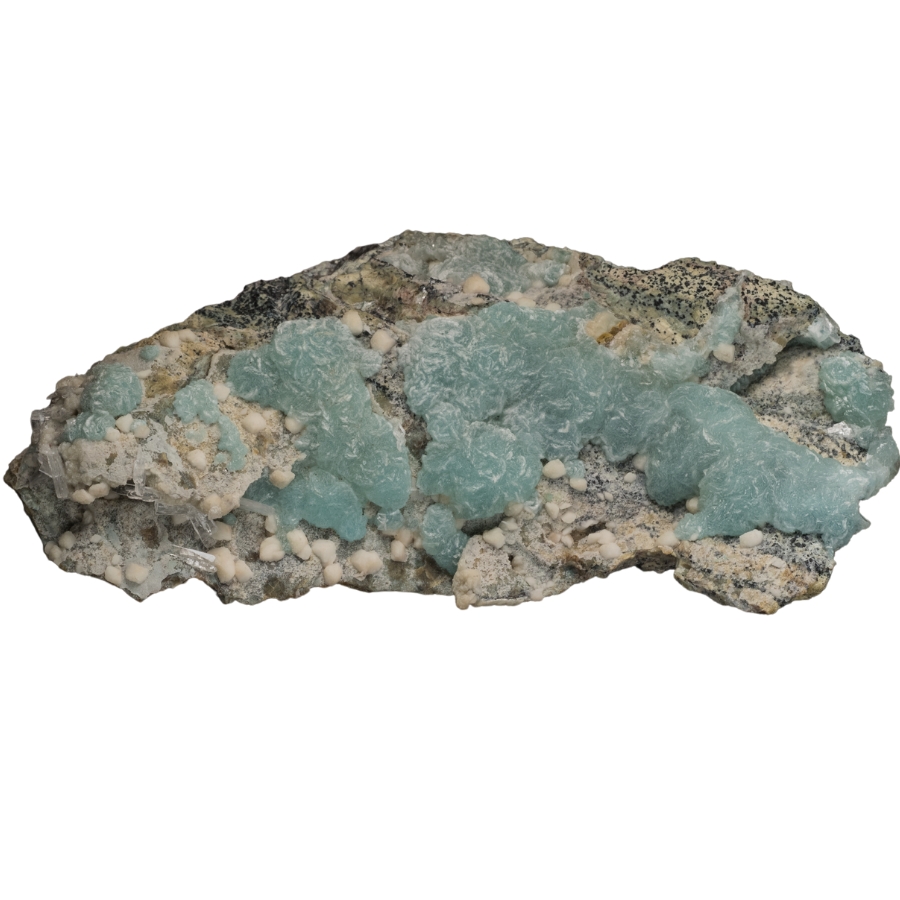
Even though brucite isn’t the most flashy crystal, it’s still pretty cool. A lot of the time, this material is white or pale green, but sometimes it can be blue or even pink.
When rocks with a lot of magnesium, like peridotite or serpentine, get wet, brucite forms. Over time, this water turns the rock into brucite through a chemical process like magic. It’s like a science project that takes a very long time.
When found in Maryland, brucite is even more special because it isn’t found very often. There are places in the state where the rocks are just right for making brucite, especially in the serpentine barrens.
These are special places where the dirt is too harsh for most plants to grow but just right for minerals like brucite to form.
It’s not the kind of brucite that makes news because it’s big and bold, but mineral fans traveling through Maryland should look for it because it’s pretty and rare.
Brucite is worth more than how it looks. In the real world, it comes in very handy. People study brucite to learn more about how minerals form and what that can tell us about the past of the Earth.
It’s also used in business to make chemicals and things that keep fires from spreading. Brucite is a mineral that plays many essential parts in nature and our daily lives, even though it may not be as well known as gold or diamond.
Where you can find Brucite in Maryland
Brucite that is one of a kind can be found in the following places:
- Reed Mine
- Walken Mine
- Rock Springs
Covellite
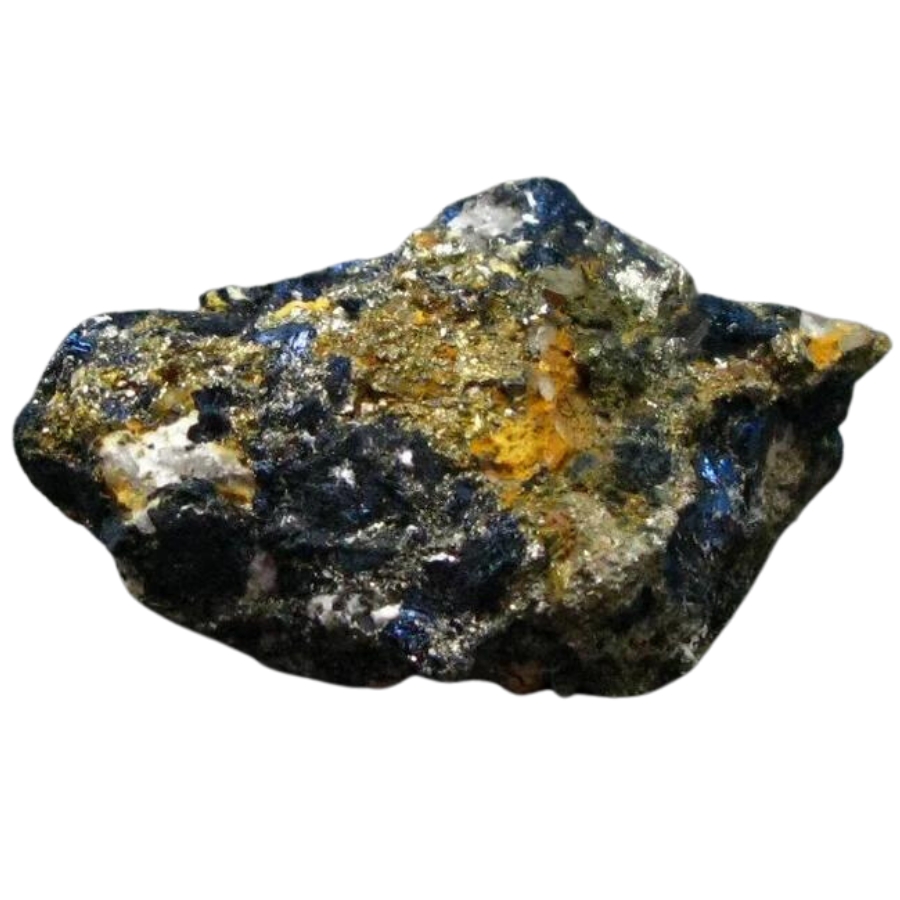
The crystal covellite looks like a piece of the night sky has been set in stone. Indigo blue is a deep, beautiful color that can sometimes flash with a shiny sheen resembling stars.
Copper sulfide is what covellite is made of, and it usually forms where copper is present, generally when other copper sulfides like chalcopyrite are changed.
Either very hot places deep underground or hot seas that break down and rearrange the elements in the original copper minerals can cause this process to happen.
Covellite isn’t something you’ll usually find in Maryland, but you can find it. It tends to hang out in old copper mines and other places where copper friends are.
Because Maryland used to be a mining state, you might find this deep blue beauty in the right places while searching old mine dumps or natural rock outcrops.
Maryland’s covellite is a real treat for geology and mining history buffs because it tells a story of the state’s past industry activities.
People like covellite not only because it looks nice but also because it has copper in it, which is very useful for plumbing and wires. People who like minerals also like it because of its unique color, and it can be cut into jewels for jewelry.
While covellite may not be the most well-known mineral, it’s loved for its usefulness in earth science and its beautiful look, which can add a splash of deep blue to any crystal collection or jewelry box.
Where you can find Covellite in Maryland
These places are where you can find covellite:
- Dollyhyde Creek
- Hammond Prospect
Smithsonite
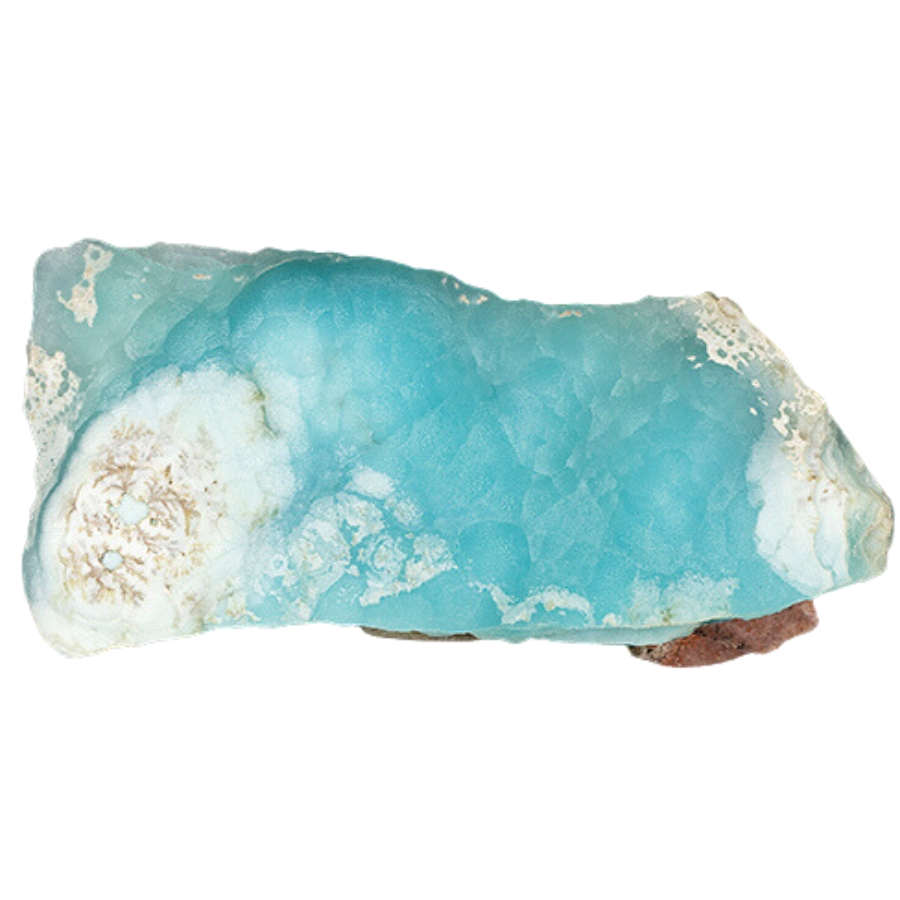
You might think Smithsonite is a different material because it looks like a different color. It could be white, blue, green, or pink. Fun fact: it’s often found in round, bubbly shapes resembling little grape clusters.
There is a chemical process that turns the zinc sulfide minerals into smithsonite when zinc ore deposits are exposed to air and rain. It’s kind of like cleaning in nature!
You won’t find smithsonite anywhere in Maryland, but you might find it in the right place, like near old mines where zinc was once found.
Maryland’s smithsonite is a real gem that not many people know about! You won’t find something like that every day, but that makes it more exciting when you do.
Several things make Smithsonite very valuable. Zinc is in it, and we use it to make many things, such as metal alloys and even sunscreen.
But smithsonite isn’t just useful; mineral fans also love it for its unique look and the way it can sparkle just right when you polish it.
Also, smithsonite has a background behind it—it was named after James Smithson, who started the Smithsonian Institution. That’s why smithsonite is more than just a pretty stone. It has science, history, and a little sparkle all in one.
Where you can find Smithsonite in Maryland
There are a lot of places in Maryland where you can find smithsonite:
- Liberty Mine
- New Windsor
Tourmaline
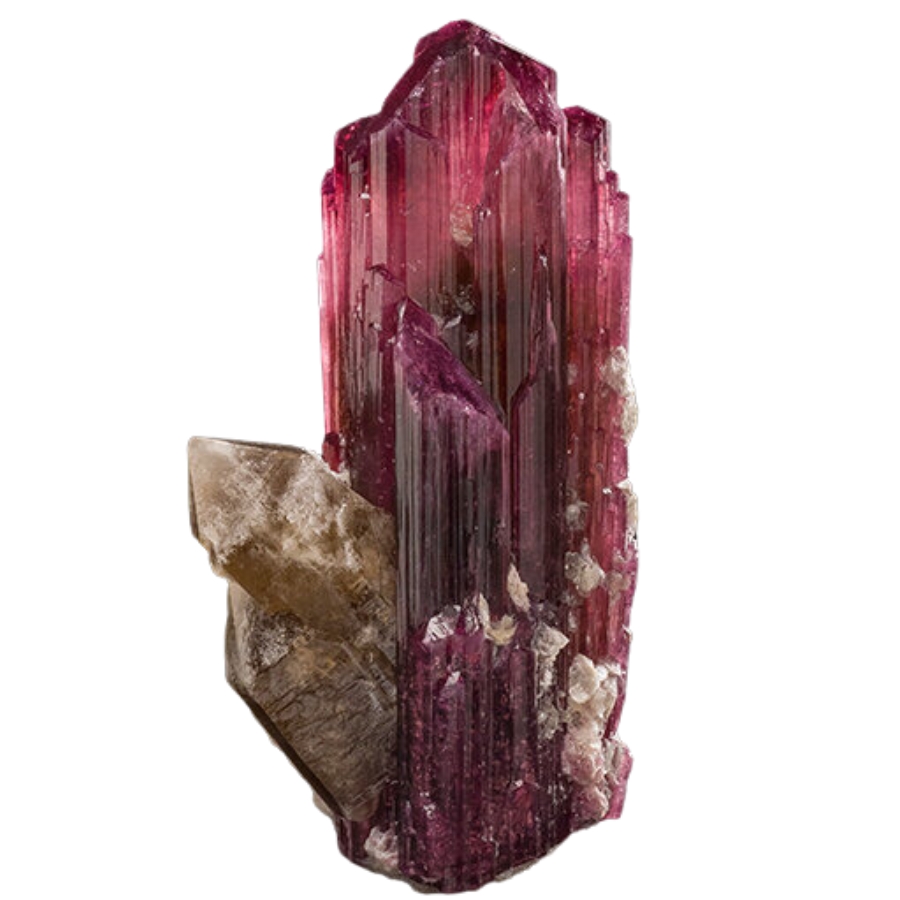
You can find tourmaline in almost every color you can think of. It’s known as the rainbow of gems. It has various colors, from bright blues and greens to pretty pinks and cherry reds.
Mixed with other things, this bright gem is made of aluminum, iron, magnesium, and more. When hot, mineral-rich water flows through cracks in certain types of rocks deep beneath, it makes it.
As the water cools down, tourmaline begins to crystallize, similar to how sugar turns into rock candy.
Tourmalines are especially easy to find in the central part of the state, where pegmatites are found, which are rocks that are like treasure chests for gems.
Most of the time, the tourmalines in Maryland aren’t the big, fancy jewelry-quality gems, but they’re still cool to find and look at. Even though they are small, their color and shine make them very powerful.
Tourmaline is valuable because it’s both pretty and one-of-a-kind. Each piece has its design and mix of colors. Yes, it’s used a lot in jewelry, but scientists who study how the Earth works also find it interesting.
When people look at tourmaline, it can tell them about the underground conditions where it formed. As you can see, tourmaline is a unique gem that stands out, whether in a collar or a science experiment.
Where you can find Tourmaline in Maryland
Pieces of tourmaline can be found in the following places:
- Baltimore County
- Granite area quarries
- H.T. Campbell Quarry
The Most Valuable Rocks and Minerals in Maryland
Let’s talk about the famous rocks. These rocks and gems are very valuable and can be good to own.
Patuxent River Stone
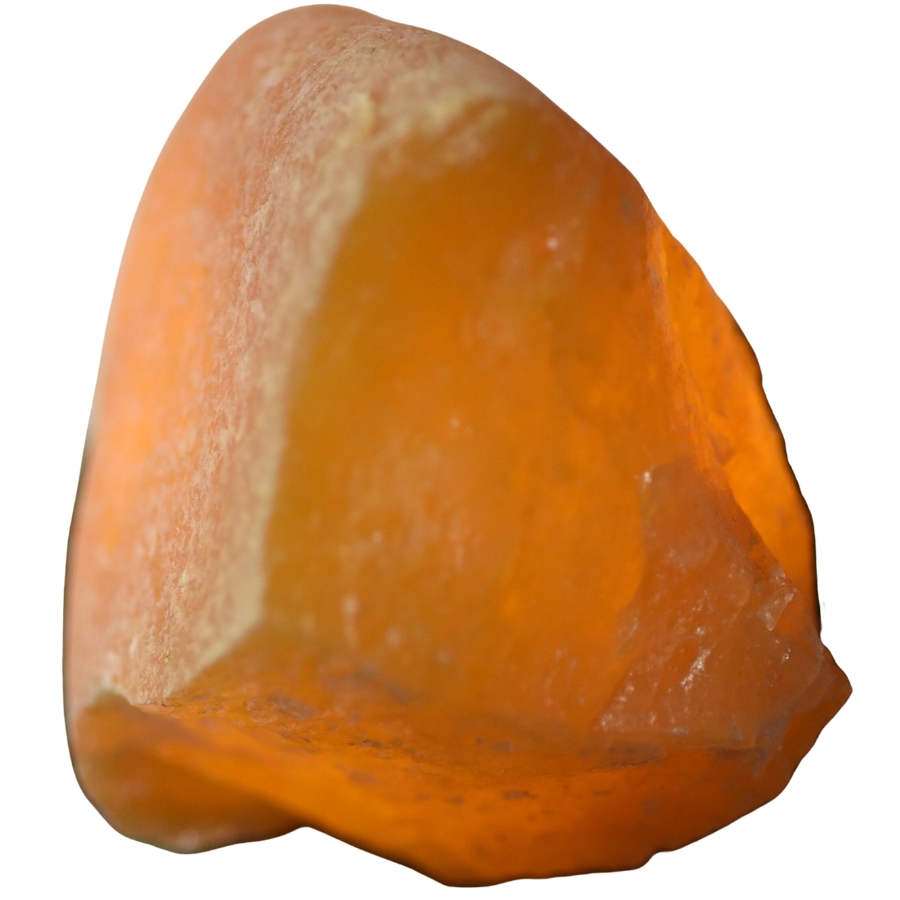
The Patuxent River Stone is the official state gem of Maryland. It’s as special as the state itself. This unique stone is an agate, a bright form of quartz with bands.
It’s pretty cool because every stone is unique and has its layers and waves of color. The Patuxent River Stone gets its name from its location near the Patuxent River.
It forms when water high in silica flows through rock, leaving behind layers that harden over time to form the agate we see today. It takes a long time, like how an oyster makes a pearl.
You can find the stones in the dirt and soil next to the Patuxent River. New ones come to the surface after it rains a lot.
They’re not the big, flashy gems you might see in a jewelry shop. Instead, they have a quiet beauty. Their smooth sides have bands of orange, yellow, brown, or white.
The Patuxent River Stone is important to people because it is beautiful and linked to Maryland. You can hold this small piece of the state’s natural past. People who like to collect things love it because each stone is unique.
It also stands for the state because it shows how beautiful Maryland’s rivers are and the stories they hold. The Patuxent River Stone is a real Maryland gem, and it looks great as a pendant or just sitting among other stones.
Where you can find Patuxent River Stone
You can find Patuxent River Stones all over Maryland, especially at the Patuxent River, since it’s the state’s official gemstone.
Vesuvianite
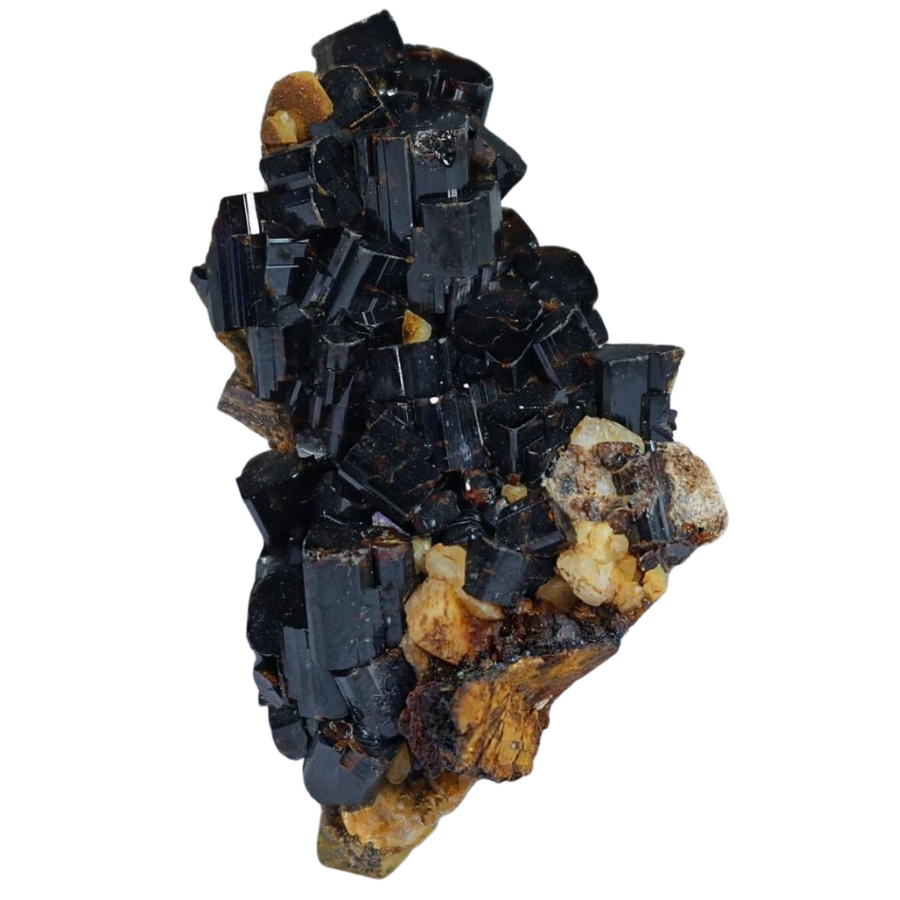
Vesuvianite, sometimes called idocrase, is an interesting crystal that changes colors like a chameleon, going from brown to green to yellow and even blue or purple.
It was first found on Mount Vesuvius in Italy, where it got its name. But you can find this cool mineral all over the world. It forms when volcanic rocks are heated and pressed together, a process scientists call metamorphism.
It works like baking clay in an oven, but it takes a very long time and takes place deep in the Earth.
It is most common in places where volcanoes have erupted in the past or where heat and pressure have changed limestone.
If you’re lucky enough to find vesuvianite in Maryland, it will probably be in the form of small, rough pieces that look like glass. Even though they’re not very big or showy, they’re cool pieces of Maryland’s natural puzzle.
Several things make vesuvianite valuable. People who like collecting minerals love it because it comes in many colors and sparkles in the light. Because it looks different and lasts a long time, jewelers like to use it in their work.
It’s also often found with other valuable stones, like garnet and diopside. This can mean that there are more gifts nearby. It brings a touch of Earth’s deep beauty into our lives, whether it’s in a rock collection or a piece of jewelry.
Where you can find Vesuvianite in Maryland
You can find vesuvianite specimens at the Appalachisn regions of Maryland.
Williamsite
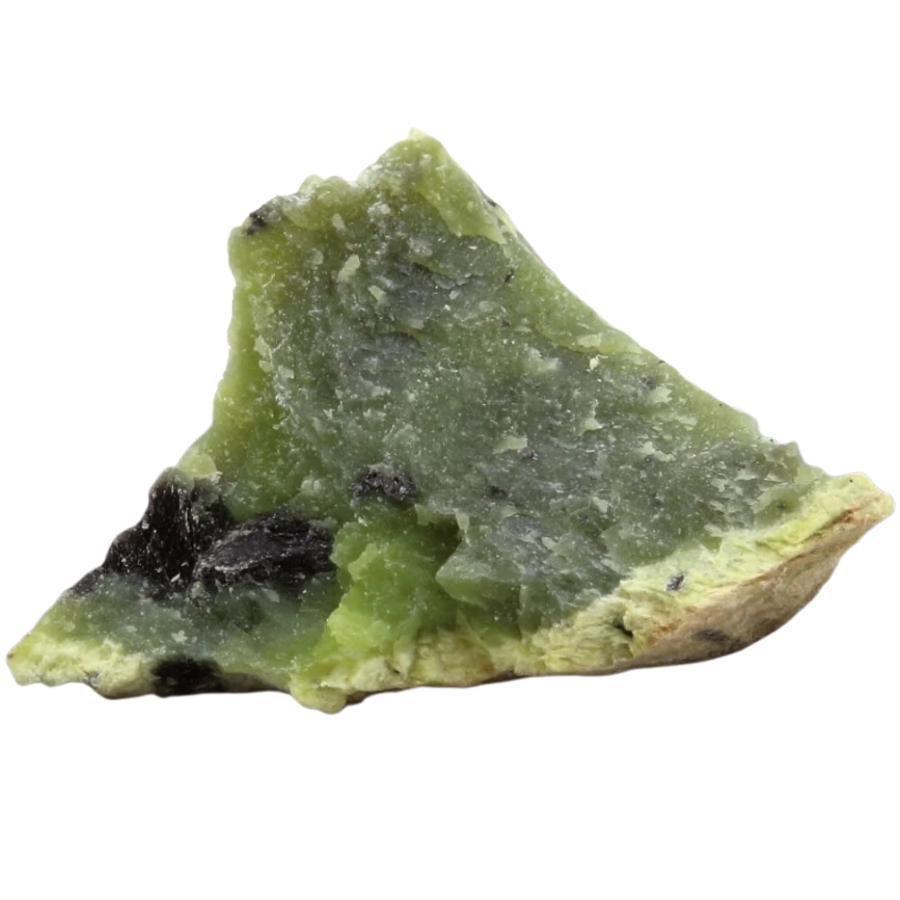
Williamsite is a unique and rare form of serpentine, a green mineral that looks like wax. It’s fascinating because it often has these incredible, see-through spots that feel oily or soapy when you touch them.
There is a bit of chromium in this gemstone, which makes it a brighter green. It’s made of the same stuff that most serpentine rocks are made of. An area with a lot of serpentine rocks is likely to have it.
It’s found in the state’s serpentine barrens, areas where the soil is full of serpentine minerals and not much else likes to grow. These barrens create just the right conditions for williamsite to form.
While you’re not going to find it just lying around everywhere, in these serpentine-rich areas, you might spot some.
As a mineral, it’s pretty rare, which always makes it more attractive to gem and crystal collectors. The rich green color and the way it can be cut and polished to a beautiful shine make it an excellent stone for jewelry, even though it’s not as hard as others.
Also, you can only find it in certain places, which gives it an air of mystery, like a hidden gem there to be found. Williamsite has its unique charm, whether in a ring or a collection.
Where you can find Williamsite in Maryland
Here are some places where you can find williamsite:
- Green Marble Quarry
- Funks Pond Recreational Area
- Rock Springs
Zoisite
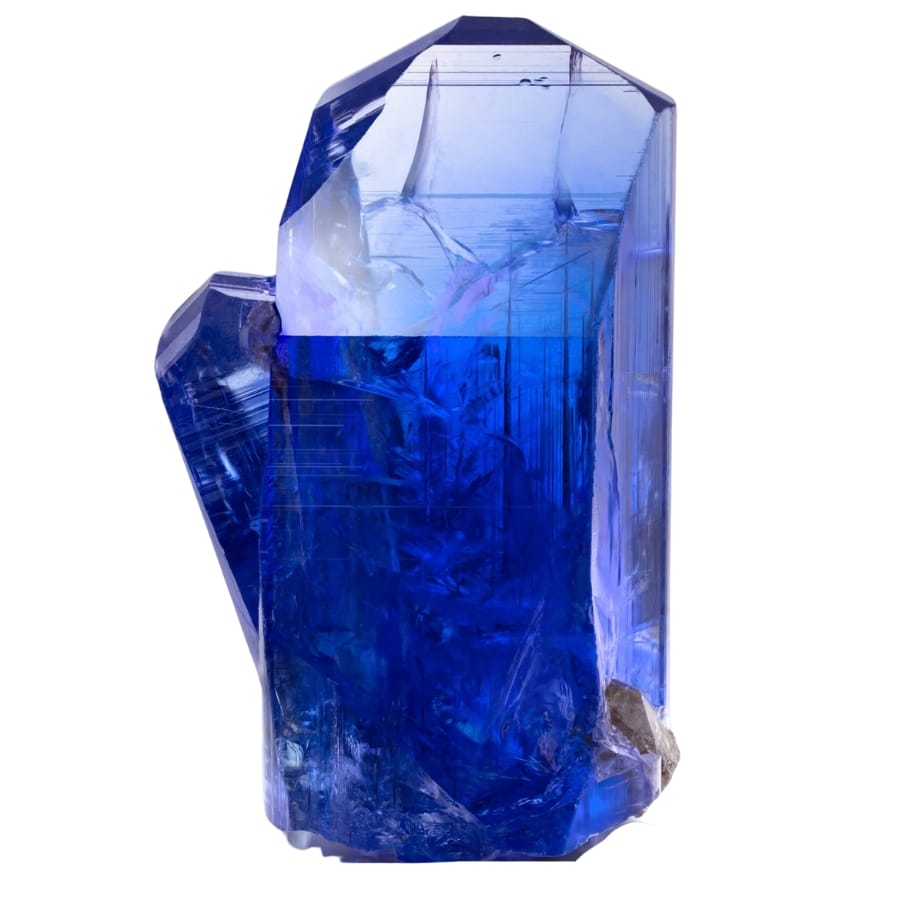
Zoisite is a crystal that is very interesting because it can change colors so quickly. It can be green, brown, blue, or even purple. Tanzanite, a bright blue-purple zoisite, is the most well-known type, but we don’t find that type in Maryland.
Hot rocks that are high in calcium and aluminum get squished under the Earth’s surface, which makes zoisite. With a lot of pressure and time, it’s like a rock getting a major makeover. It changes into something much cooler.
Like the old mountains and rivers that run through the state, it might be found where the rocks have been through a lot. Zoisite from Maryland isn’t as bright blue as tanzanite, but it has its kind of soft beauty.
Its colors, like greens, browns, and sometimes a rosy pink, make you think of the earth.
Zoisite is valuable for more than just its looks. When cut and polished for jewelry, it can look very pretty. Fans of rocks and scientists who want to learn more about how they form will also enjoy it.
Also, zoisite is a material that changes when it is pressed, which makes us think that stress can sometimes bring out the beauty in things.
Zoisite is a beautiful gem that shows how different nature’s works can be. It can be worn as a necklace or added to a rock collection.
Where you can find Zoisite in Maryland
Zoisite can be found in the following places:
- Bare Hills
- Sykesville area
How to Identify The Rocks and Minerals You Find
There are many reasons why it’s essential to be able to tell rocks and minerals apart. People use it to learn about the geological past of a place, figure out how important mineral deposits might be, and enjoy the beauty and variety of what Earth has to offer.
It can be hard to tell what kind of mineral something is because there are so many. You need to be able to carefully observe, know how minerals are made, have good resources, and sometimes try out new tools to do this.
Use a rock and mineral guide book
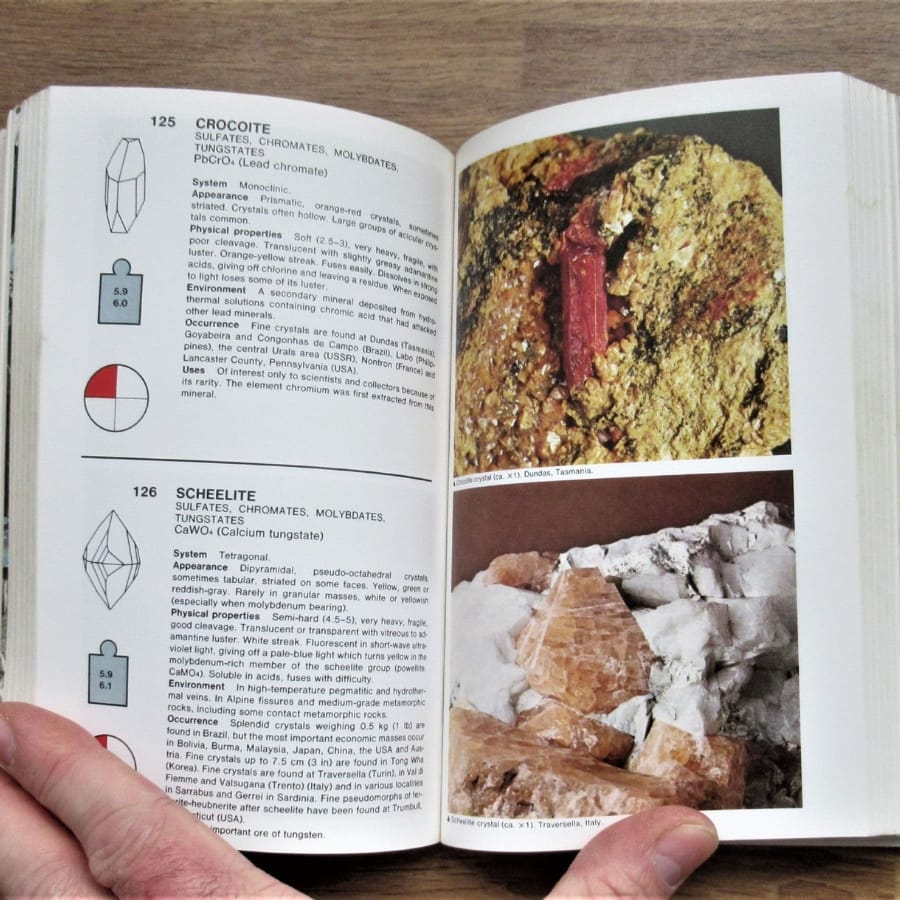
Using a rock guide to find a rock, gem, or mineral is like a treasure hunt with a map.
Start by reading the guide to familiarize yourself with the different kinds of rocks, gems, and minerals. Look at the pictures and read the descriptions so you have an idea of what each one looks like and where it’s typically found.
Rock guides usually provide clues about where certain rocks, gems, and minerals will likely be located. They might tell you the types of geographical areas, such as riverbeds, mountains, or desert regions, where you’re likely to find them.
They also explain the kind of rocks (limestone or granite) where some minerals are usually found.
When you go out looking for rocks, bring the guide along. It’s your reference book for when you find something that looks interesting.
You can compare the rocks from the photos and descriptions in the guide to see if you’ve found what you think you’ve found.
Equip yourself with rockhounding tools
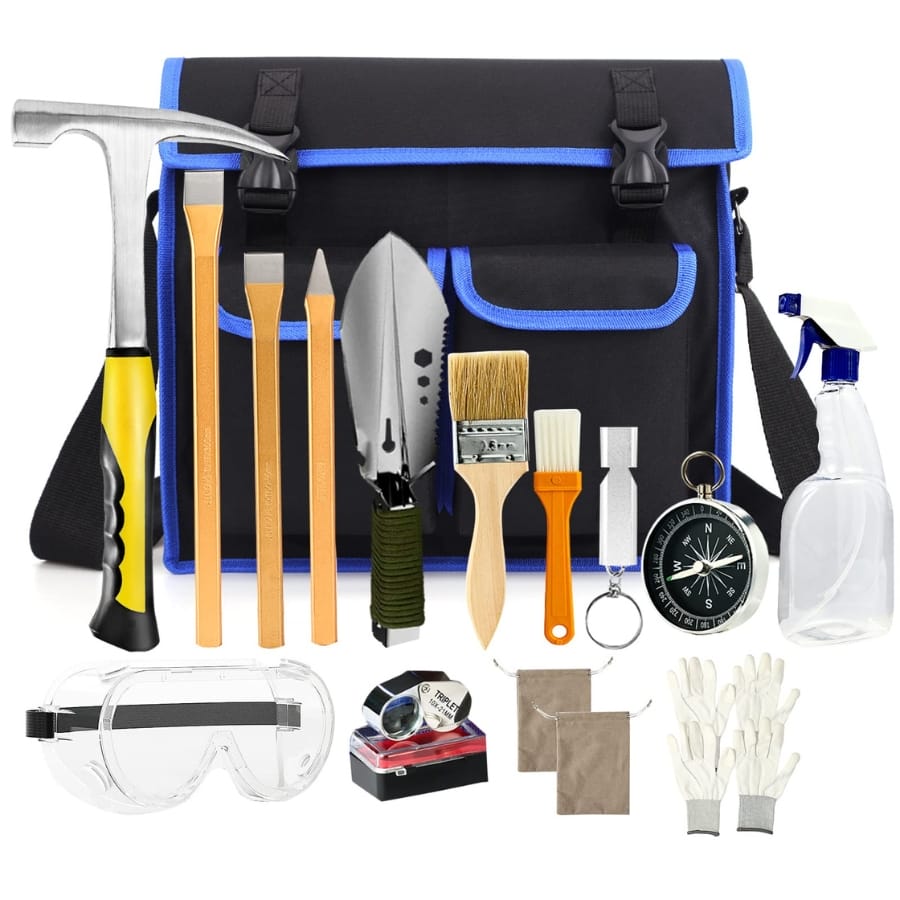
Rockhounding tools are your gear for your very own mineral mission. Picks and hammer are for carefully chipping away pieces of rock to see what might be inside. If you think there could be a crystal or mineral hidden in a larger piece of rock, you can use these tools to break it open and take a peek.
Once you’ve got a piece of rock, you’ll want to look closer. A magnifying glass or loupe can help you see the small details that might tell you what kind of mineral you have, like its crystal form, color, and whether it has layers or inclusions.
Keep a notebook to describe where you found your rock and what you noticed about it. This can help you remember and research more when you get home.
When you’re out using these tools, always remember to be safe. Wear goggles when chipping at rocks and gloves to protect your hands.
Examine the specimen’s appearance
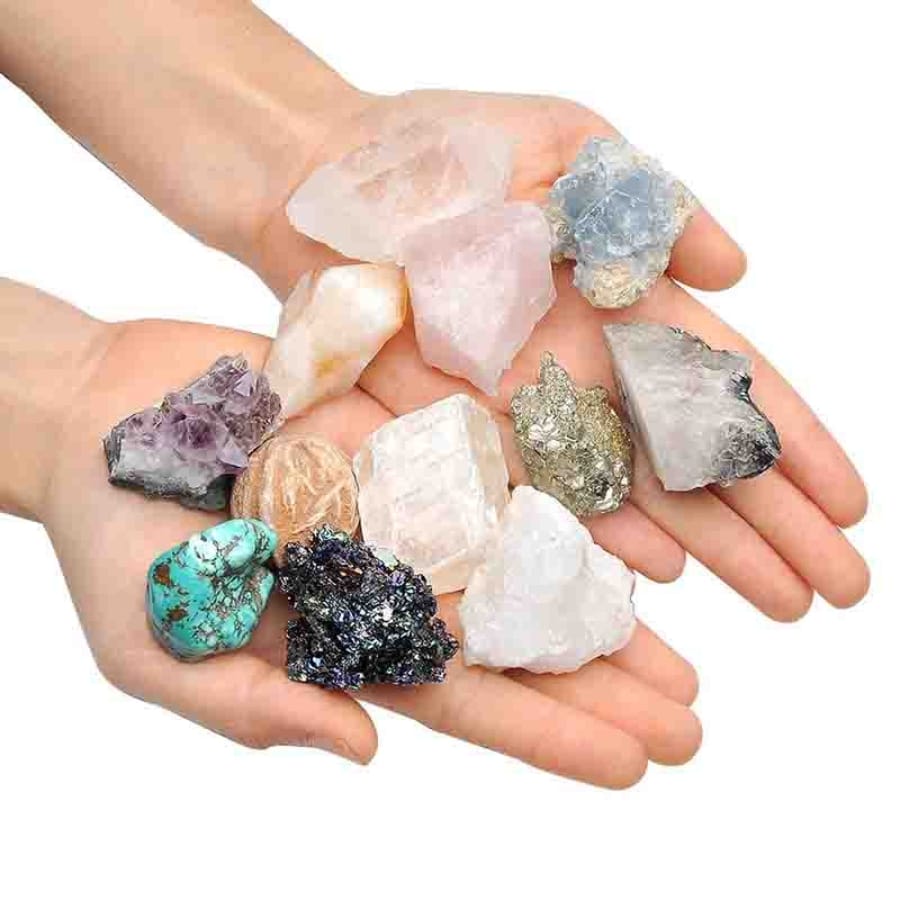
Examining a specimen’s appearance is a key step in identifying rocks, gems, and minerals.
Look at the overall color and variations in color of the specimen. Some minerals have distinct colors, while others might vary. Keep in mind that while color can be a helpful clue, it can also be misleading since many minerals come in a variety of colors.
Look at the shape of the crystals or grains. Some minerals, like halite (salt), form in cubic shapes, while others like quartz form in hexagonal prisms.
Feel the specimen. Is it rough, smooth, or does it have a waxy feel? For instance, talc feels distinctly soft and smooth.
By carefully observing these characteristics, you can narrow down the possibilities to help identify your rock, gem, or mineral.
Do a hardness test
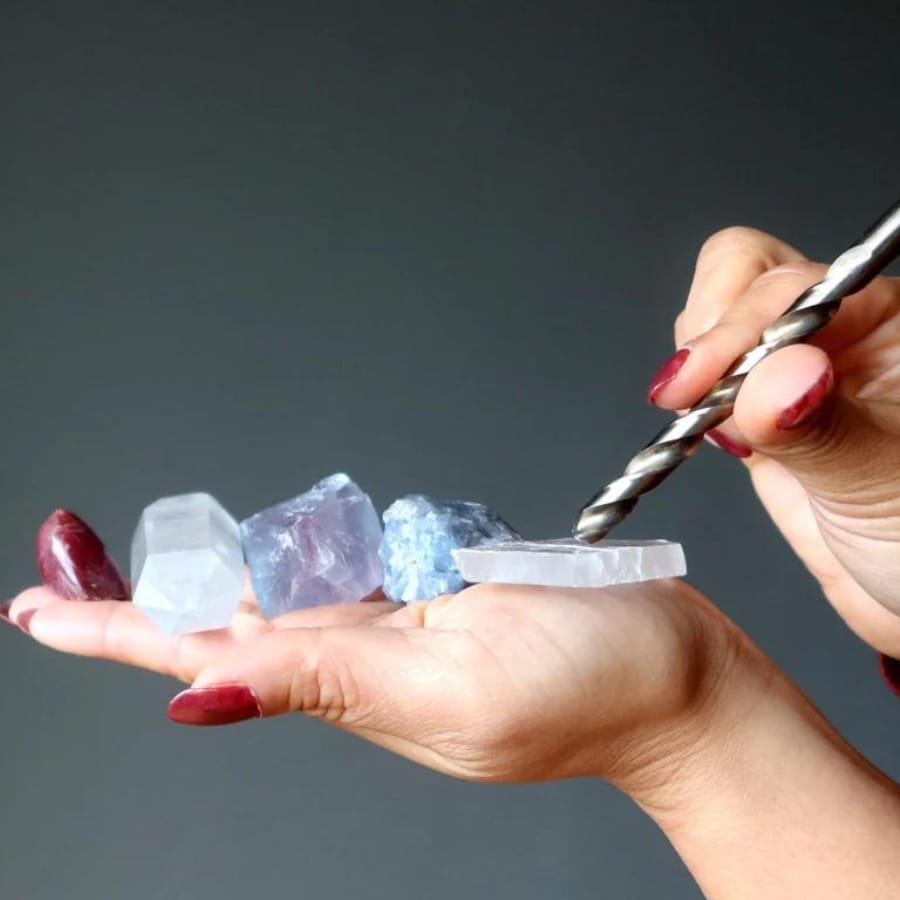
A hardness test is a way to figure out how hard a rock, gem, or mineral is by seeing what it can scratch, or what can scratch it. The test is based on the Mohs Hardness Scale, which rates minerals on a scale from 1 (very soft) to 10 (very hard).
You can use common objects to get a basic idea of hardness. For example, your fingernail has a hardness of about 2.5, a copper penny is about 3, a knife blade is around 5.5, and glass is around 5.5 to 6.
Try to scratch the surface of your specimen with the reference object. If the object scratches your specimen, the object is harder. If the specimen scratches the object, then it’s the other way around.
Use the Mohs scale to determine the hardness of your specimen. If it can scratch glass but not a piece of quartz, its hardness is between 6 and 7.
Once you’ve got a hardness value, you can look up which minerals have that hardness and compare other characteristics like color, luster, and cleavage to narrow down the possibilities.


